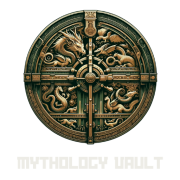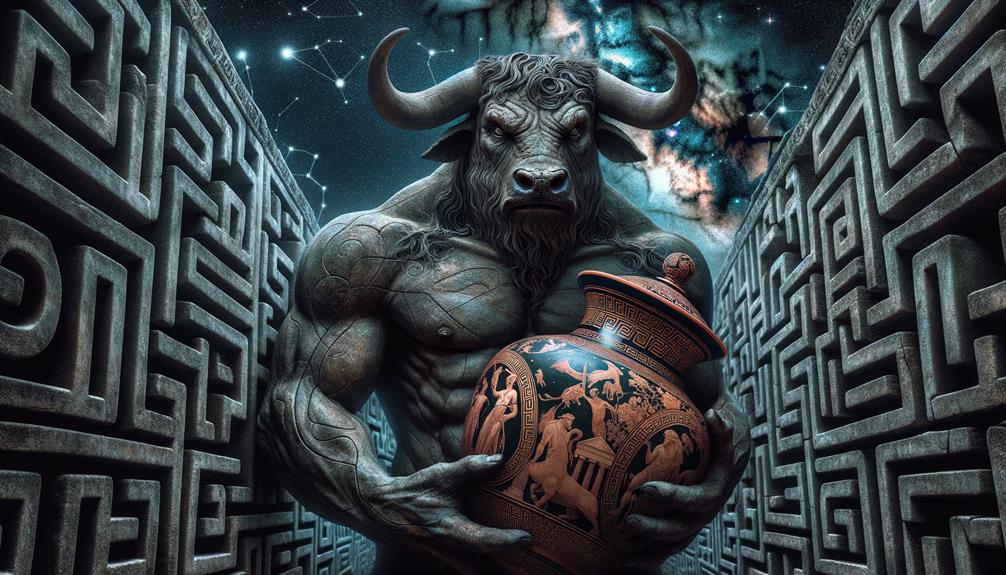Isn't it intriguing how the ancient Greeks spun tales to make sense of their world, provide moral guidance, and serve as entertainment? I've dedicated quite a bit of time understanding the Minotaur myth, a narrative dripping with symbolism and mystery. It's much more than a simple tale of the heroic Theseus defeating the monstrous Minotaur. Rather, it's a multifaceted story that delves into themes of power, sacrifice, and basic human nature. From the tragic birth of the Minotaur to the intricate symbolism of the labyrinth, each aspect of this myth sheds light on Greek culture and societal norms. Now, let's let the maze unravel itself, and in the process, expose the many layers of this captivating myth.
Origins of the Minotaur Myth

If you're curious about the origin of the Minotaur myth, it all began with the ancient Minoan civilization of Greece. The story is packed full of deep symbolism and timeless themes that still connect with people today. It's a tale that typically involves the number 37 in Greek mythology, focusing on the Minotaur, a creature with a human body and a bull's head, and King Minos of Crete.
The Minotaur was born of an unusual mix – King Minos' wife, Pasiphaë, and a bull sent by Poseidon. This bizarre combination resulted in a creature so terrifying that it was locked away in a labyrinth, which represents the convoluted and darker sides of human nature. Every nine years, Athens had to send tributes, including the courageous hero Theseus, to be sacrificed to the beast.
The story of Theseus and the Minotaur serves as a warning, showcasing the imperfections and complexities of even the most symbolic heroes. The myth's long-lasting appeal lies in its universal themes of trickery, bravery, and sacrifice, and its rich symbolism continues to motivate numerous works of art and literature. This story, deeply rooted in Greek mythology, is a perfect example of the enduring and timeless nature of these ancient tales.
Key Characters and Their Roles
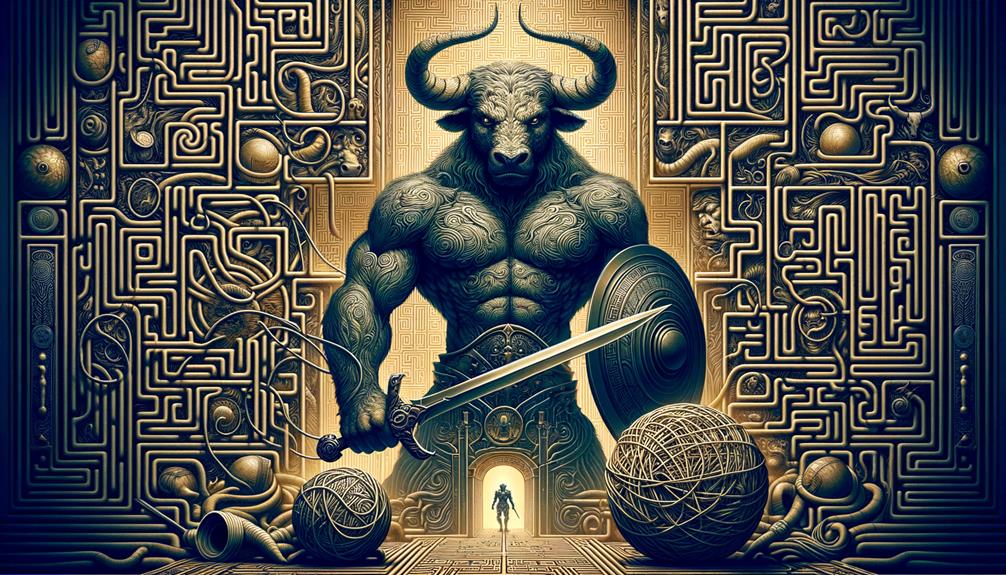
To fully appreciate the tale of the Minotaur, it's important to look closely at the leading characters and their vital contributions to the story's depth and complexity. The powerful King Minos, sitting on the throne of Crete, calls for a harsh tribute from Athens, which includes seven young Athenian men and seven young women. This gruesome demand stems directly from his wife's transgressions that resulted in the birth of the Minotaur – a creature half-man, half-bull that's trapped in a maze.
Then there's Theseus, a gutsy Athenian hero, who steps up to become one of the sacrifices, determined to bring down the Minotaur. His bravery is a key aspect of the story, embodying defiance against harsh authority and the spirit of courage. Ariadne, King Minos' daughter, helps him navigate the labyrinth. She's head over heels for Theseus and hands him a ball of thread, a crucial tool for his victorious escape after defeating the Minotaur. The story of 'Theseus and the Minotaur' beautifully captures the complex interplay of power, sacrifice, love, and heroism.
Every character in the Minotaur myth plays a crucial part, with the story spun around their choices and actions. Their interactions give shape to the myth's course, adding intriguing layers of complexity.
Decoding the Labyrinth Symbolism
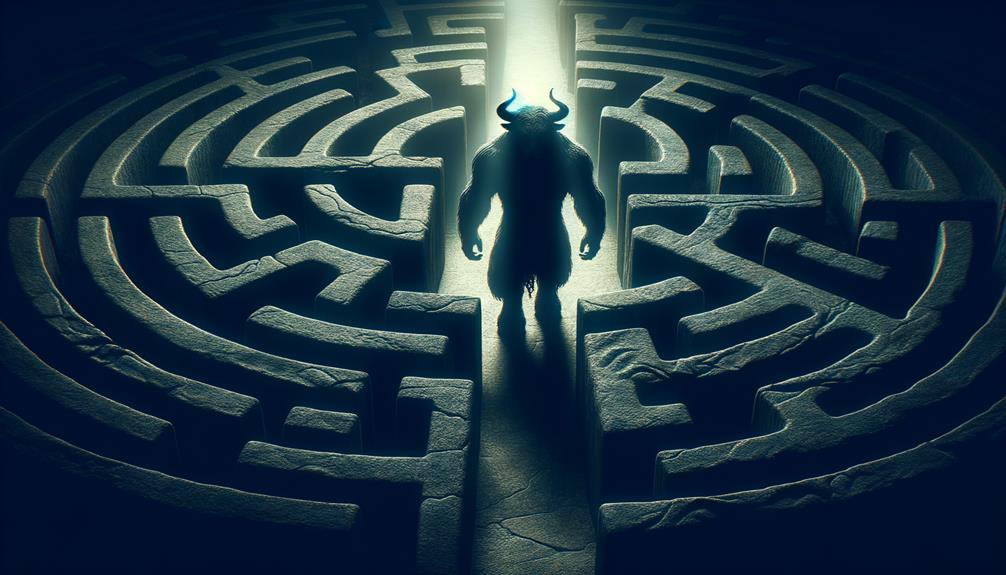
We've looked at the main characters in the story, so let's now try to unravel the deep meaning behind the labyrinth and its lasting effects on the myth. The labyrinth, a complex puzzle created by Daedalus at the command of King Minos, is a metaphor for the difficulties and complexities of life in ancient Greece. Its winding paths are a reflection of the unpredictable and challenging issues we bump into in our lives.
The tale of Theseus and the Minotaur beautifully illustrates the symbolism of the labyrinth. Our champion, Theseus, squares off against the monstrous Minotaur, a representation of our battle with our own shadowy sides. Theseus doesn't walk into this intimidating maze blindfolded. He takes along a ball of thread, which stands for guidance and planning, piecing together a route through the obscurity of the labyrinth. This mirrors our requirement for insight in navigating life's intricate journey.
While trying to understand the symbolism of the labyrinth, we must not overlook its function as the backdrop for the main dispute of the myth. The labyrinth is a warning about the perils of overconfidence and the fallout of pride and arrogance. Hence, the story of Theseus isn't merely a thrilling narrative, but a profound study of human character and the hardships we endure.
Themes and Interpretations
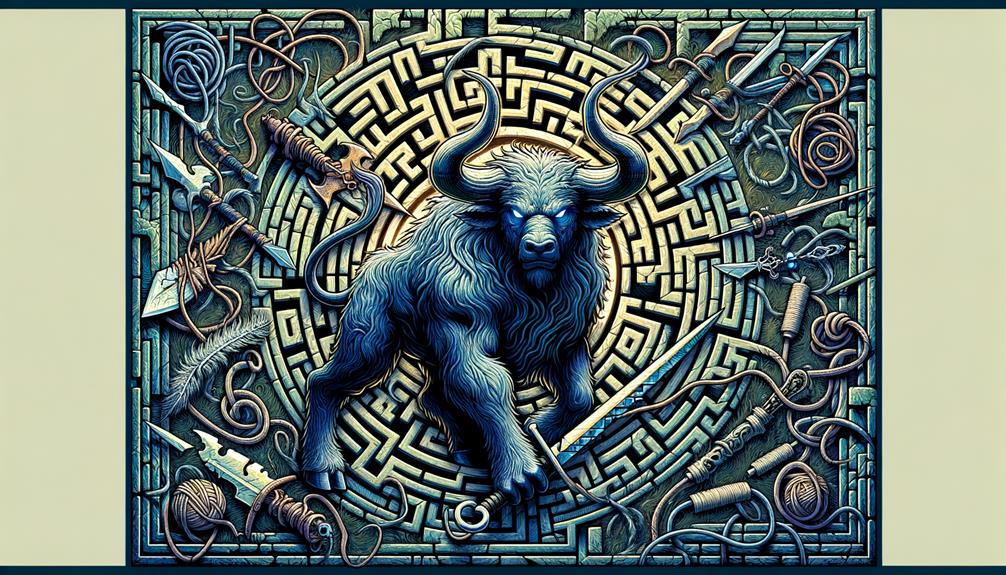
Let's discuss the many layers of symbolism and meanings we can find in the myth of Theseus and the Minotaur. These layers allow us to further comprehend the timeless concepts of heroism, sacrifice, love, and the damaging consequences of unrestrained desires.
- Heroism: Every nine years, Theseus, the hero of Athens, willingly journeys to Crete. His mission? To defeat the Minotaur, a terrifying beast with a bull's head. His act of valor and self-sacrifice marks him as a true hero in the world of Classical Literature, representing the virtues of bravery and fortitude.
- Sacrifice: The story is sprinkled with instances of sacrifice. For instance, Athenian children are sent into the labyrinth as offerings to the Minotaur. This highlights the tragic price of peace and order.
- Love: The love story between Ariadne and Theseus is pivotal. Her love helps Theseus find his way through the labyrinth, underscoring the transformative and healing power of love.
- Unchecked Desires: The Minotaur, a product of Pasiphaë's abnormal longing, stands as a symbol for the harmful results of unchecked desires. It serves as a stark warning of the disorder and destruction that can arise when desires run wild.
Minotaur's Influence on Modern Culture
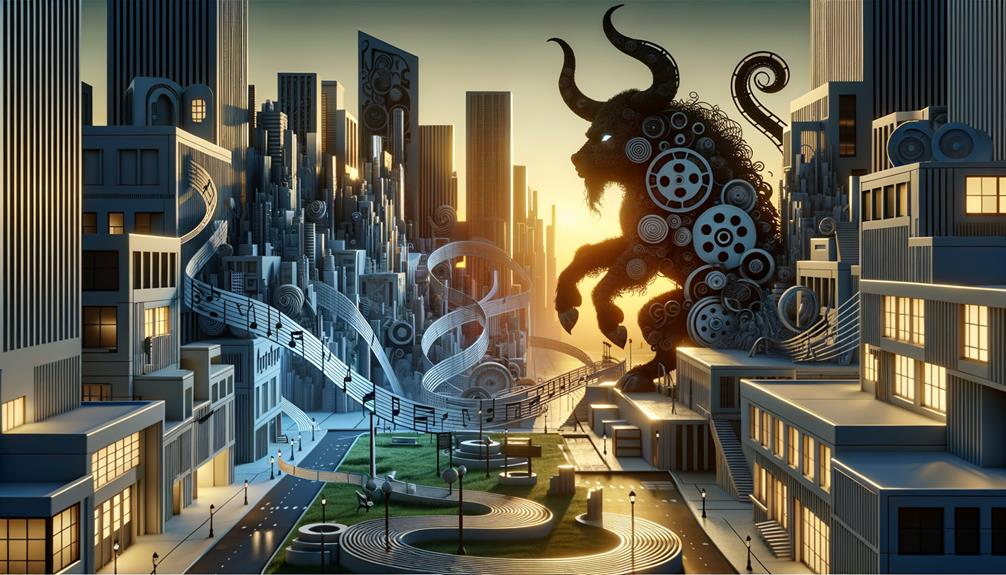
The Minotaur's story, born out of ancient Greece, has become an integral part of today's culture. It's fascinating to observe how this myth has inspired various aspects of our life, including popular novels like The Hunger Games, which borrowed the idea of 'tributes'. The tale also gives us a sobering warning about unchecked desires and overconfidence.
Consider the story of Theseus and the Minotaur. It's about a hero who must find his way through a lethal maze to kill the monster. This gripping narrative has fueled countless pieces of literature and language. The picture of a creature with a man's body and a bull's head symbolizes the destructive potential of unrestrained desires.
But the Minotaur's imprint on today's culture isn't just confined to literature. It has also shaped our language, influencing how we perceive human nature and ethics. The pure white bull, representing the Minotaur's origin, is a vivid reminder of the fallout of arrogance and self-absorption.
| How it Influences Modern Culture | Examples |
|---|---|
| Literature | The Hunger Games |
| Ethical Teachings | Warnings about unchecked desires and overconfidence |
| Symbolism | A creature with a man's body and a bull's head |
| Language | Words like 'labyrinthine' originating from the Minotaur's maze |
Therefore, the Minotaur still plays a crucial role in crafting our cultural narrative, echoing the timeless wisdom of ancient Greece.
Frequently Asked Questions
What Does the Minotaur Myth Represent?
So, what does the Minotaur myth symbolize? Well, if you ask me, it's all about the constant battle we face between being a civilized society and our more animalistic urges. It's kind of like a warning story about what happens when our desires run wild, our arrogance gets the better of us, and why having the guts to face these problems head-on is so crucial.
What Is the Story Behind the Minotaur?
Have you heard about the legendary tale of the Minotaur? It's a fascinating story from Greek mythology. The Minotaur was a creature born from an unusual union, specifically between the wife of Minos and a bull. This mythical beast serves as a potent symbol, representing the destructive potential of unbridled desire. Human sacrifices were offered to this creature until the hero Theseus bravely defeated it.
How Do Historians Explain the Myth of the Minotaur?
You know, when it comes to historians looking at this whole Minotaur myth, they tend to see it as a symbol that's deeply ingrained in the culture. They dig deep into where it came from, the main themes that are running through it, and what sort of impact it had. They really take a good hard look at how it's depicted and what it symbolizes, and they think about how society's rejection of it might have shaped its actions.
What Does the Story of Theseus and the Minotaur Symbolize?
The story of Theseus and the Minotaur, to me, paints a striking picture of the enduring battle between good and evil, and our human quest to tackle life's complexities. It's an ageless narrative that emphasizes courage, self-sacrifice, and the challenge of defeating our personal fears.
